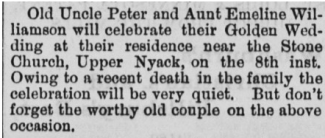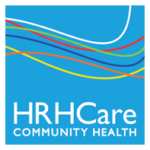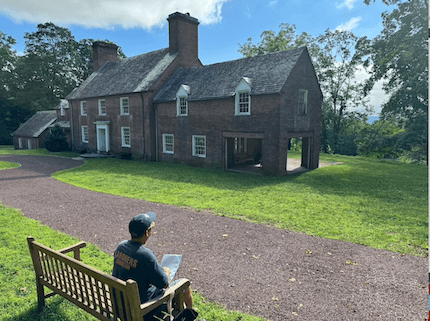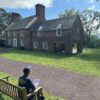
Old Stone Meeting House on N. Broadway was built, at least in part, with slave labor.
Peter Williamson died in Upper Nyack in January, 1886. He was said to be the last living person in Rockland County born in bondage. Peter was born into slavery on the 90-acre Williamson farm in Upper Nyack, taking on the last name of his owner. He was one of many slaves on the property. He was said to have worked as a boy in bondage on the building of the Old Stone Meeting House. Peter married Emeline, also from Nyack, and raised a family of 7 including 2 sons who served in the Civil War. At one time, the Williamsons lived near the Old Stone Meeting House and Peter ran a small grocery and candy store, probably at the same location. Not much of Peter Williamson’s story remains today, but what does remain is testament to his perseverance and the area’s culpability.
Slavery in New York State
Slavery was a part of New York from its first settlement by Europeans. In 1626, 11 slaves were unloaded into New Amsterdam. Some slaves earned freedom, or “half-freedom” even, while an active slave market operated at the end of Wall Street from 1721 to 1762. The grip of slavery didn’t begin to lessen until 1781, when African Americans who fought in the Revolutionary War were given their freedom.

The evils of slavery as presented in pre-Civil War abolitionist literature.
In 1799, the New York State legislature passed one of the most egregious emancipation laws ever, called the Act for Gradual Abolition of Slavery. Children born after July 4, 1799 were declared free… BUT they had to continue to serve as slaves: 28 years for men and 25 years for women. Slaves born before the Act were considered to be indentured servants. In other words, slavery continued but it wasn’t called that. The Act was amended in 1817, freeing all slaves born before July 4, 1799 while keeping the children born after 1799 enslaved. It wasn’t until 1827 that there was total emancipation. On July 5, 1827, an emancipation parade was held in New York City–July 5 being chosen because July 4 was a white man’s holiday.
Slavery in Rockland County
Frank Green and other late 19th century local historians gloss over the impact of slavery in Rockland County, even reporting that slave owners were kind and reasonable. Green said that Rockland slaves were “thievish, lazy, and useless trash.” While slave owners rarely owned more than a few, slaves accounted for 8.7% of the county population at the time of the Gradual Abolition of Slavery Act. An additional 1% of the population were free Black Americans. This is by no means a trivial number.
Cornelius Kuyper, the first settler in Upper Nyack, had slaves on his farm. The Tallmans, the first settlers in Nyack, undoubtedly were slave owners as well.
Rockland Runaways

Runaway notice from Michael Cornelison of S. Nyack who himself was abducted and imprisoned by the British in 1776.
One of the most graphic images of slavery in New York can be found in newspaper ads offering rewards for runaway slaves. Michael Cornelison, a well-known landowner in S. Nyack, advertised for return of Scipio in 1784, whom he purchased from Andrew Bushwick. Scipio was about 40, wearing a blue jacket and breeches, grey stockings, and a new felt hat. He had run once before to the “enemy” in 1776, presumably seeking out the British in return for freedom. But 8 years later, he was on the run. The reward was $3.
Even after the Gradual Abolition of Slavery Act, owners were seeking runaways. Nicholas Lansing of Orangetown posted an ad in 1814 offering a skimpy $1 reward for Isaac, “a Negro boy” of “slow speech,” aged 21. Masters of sailing vessels were warned not to harbor or employ Isaac as they would be prosecuted with rigor by Lansing.

Orangetown runaway notice from 1814 after the Gradual Abolition of Slavery Act.
Presumed runaways were often jailed until someone claimed them and paid charges. In 1767, for instance, Abraham Smith was jailed in Orangetown, claiming his master, Benjamin Smith of Rhode Island, died and he was left free. He was about 30, tall, and the jailers noted he had a scar across a toe on his right foot.
The Williamson Estate

1776 map showing Upper Nyack’s six major farms. The Williamson “plantation” sits it the very center.
Jeremiah Williamson acquired a farm of about 90 acres around 1750. The farm stretched from the Hudson River west to above 9W, north of Upper Nyack Brook. The Williamson “plantation,” as it was called in a lengthy 1932 article in City and Country, was run by a master and mistress who were said to bear terrific burdens in managing their slaves. Running a farm of this size was surely a huge task, and in the Colonial period, doing so would have been impossible without slave labor.
Slaves lived in small homes on the farm. After Emancipation, Nicholas Williamson is said to have deeded a cabin on the farm to a former slave. The heirs of this slave, of which there were 16, were forced to sell to S. R. Bradley, a leading citizen of 19th century Nyack, according to the newspaper article. Deeds that conveyed ownership of slaves to the Williamsons were kept as a family heirloom. A granddaughter, Mrs. Dutcher, claimed to have copies in 1932.
The Williamsons’ manor house, called the Moorings, still stands today on North Broadway.
Peter and Emeline Williamson

Photo of a house on N. Broadway by Frank Brush circa 1890 that could be or is similar to the Williamson home and grocery store. Notice how close it is to the road. Courtesy, The Win Perry Jr. Collection.
Peter Williamson’s birth year is not known precisely. As Frederick Douglas put it,
By far the larger part of the slaves know as little of their ages as horses know of theirs, and it is the wish of most masters within my knowledge to keep their slaves thus ignorant.
Most documents list “about” 1805 as Williamson’s birth year, but it is likely to have been earlier, and may have even occurred before the turn of the century. Whatever the date, Peter Williamson was likely born into the stew of slavery by another name during the time of the Gradual Abolition Act. As a slave, he carries the name of his owner. Just before his birth, the 1800 census numbers 4 slaves on the farm, 2 white adults, and a child. As a young boy, Peter was put to work building the Old Stone Meeting House in 1813 by his owner, one of the church’s first trustees, Nicholas Williamson. Nicholas probably contributed efforts from his other slaves. The historic marker on the current church does not note that, at least in part, the church was built with slave labor. Exactly when Peter gained freedom is unknown. It could have been as late as 1827, the time of complete abolition of slavery in New York State.

Detail of Upper Nyack map showing N. Broadway and Birchwood Ave. The Maxwell house, where the Upper Nyack Elementary School is now located, has a semi-circular drive with tennis courts to the south. Just across the street near the Old Stone Meeting House is the Peterson home, very close to N. Broadway.
Peter married 18-year-old Emeline on June 8, 1835 in Tappan. They have their first of 7 children the next year. Peter worked as a quarryman for a time, perhaps at the quarry from which stone was used for the Old Stone Meeting House. As early as 1850, he worked as a shopkeeper selling candy and groceries. His store may have connected to or near the family home that was on N. Broadway near the Old Stone Meeting House. The Rockland County Journal reported that the store was torn down shortly after Peter’s death.
The store was popular and so was “Pete” as he was known. He was described as a well-respected, quiet, unassuming, and frugal man. The Williamson store was burglarized in 1873 and 1877. $25 worth of goods (about $700 in today’s dollars) were stolen in 1877. No thieves were caught either time.
Emeline worked as a housekeeper for the Maxwells, owners of a large estate that included what is now the Summit School, the Upper Nyack Elementary School, and the Field Club on Midland Ave. Emeline was given use of a home (or perhaps promised ownership) that was close to N. Broadway near the Old Stone Meeting House and just across from the U-shaped driveway to the Maxwell house.
In a historical puzzle, an 1876 map shows a small plot of land owned by P. Williamson on Old Mountain Road across from the Upper Nyack School and an African-American cemetery. Was this land deeded to him from his former owner? Did he or his family ever live there? History yields no answer, though records show the family living on N. Broadway for many years.
A Golden Wedding Anniversary
 In 1885, the Williamsons celebrated their 50th wedding anniversary at the family home on N. Broadway. It was a quiet affair but important enough within the community to be mentioned in the local newspaper where “Aunt” Emeline and “Uncle” Peter were said to be “highly respected by their neighbors,” a large number of whom dropped by with gifts of gold. The newspaper articles mention that the Williamsons were given the house by the Maxwells for the 30 years of service to them. Two weeks, later the newspaper printed a correction, that the Williamsons had no claim on the home but had been kindly allowed to remain there.
In 1885, the Williamsons celebrated their 50th wedding anniversary at the family home on N. Broadway. It was a quiet affair but important enough within the community to be mentioned in the local newspaper where “Aunt” Emeline and “Uncle” Peter were said to be “highly respected by their neighbors,” a large number of whom dropped by with gifts of gold. The newspaper articles mention that the Williamsons were given the house by the Maxwells for the 30 years of service to them. Two weeks, later the newspaper printed a correction, that the Williamsons had no claim on the home but had been kindly allowed to remain there.
Tragically, Peter died seven months later at the age of (at least) 81, the last living former slave in Rockland County. His funeral took place in the Old Stone Meeting House, and he and Emeline were both buried in Rockland Cemetery.
Controversy at the Williamson Home

Across from the tiny Williamson home was the Maxwell estate house in which Emeline Williamson worked. The house later became the home of the Nyack Country Club.
In 1892, the Village of Upper Nyack proposed widening N. Broadway. The Williamson house was close to the road, and in the way. Emeline refused to move. The Upper Nyack Village Attorney ruled that she could not be summarily removed as she had a life right to the home by adverse possession. The village agreed to move her house back beyond the line of improvement at their expense and Emeline consented then that her land could be used.
That ruling, nonetheless was challenged in 1897 in the eternal partition hearings for the heirs of the Maxwell estate who died in 1873. Emeline claimed to have been ceded an entire acre by Mrs. Maxwell but as Hugh Maxwell survived her, no property transfer was possible. Rather heartlessly, Hugh Maxwell Jr. threatened eviction proceedings against Emeline so that the partition could be settled.
Emeline died at her home in 1898. It’s unknown if she had been born into bondage. If so, she would be the last known person to have born into bondage rather than her husband. Her daughter Almira administered the estate and was living in the Broadway home with five grandchildren at the time. The home was later to be incorporated into the estate of Justin duPratt White.
The Williamson Children

The 26th USCT training on Riker’s Island.
The Williamsons had seven children. Many remained in the area serving as gardeners, laborers, waiters, laundresses, and housekeepers. A daughter, Isabelle, worked in the home of David Smith in S. Nyack while raising 13 children. Samuel, the oldest, was listed as a registered seaman at the age of 22 in 1858.
George, the second oldest, served in the 26th Regiment United States Colored Infantry as a private. He trained at Riker’s Island and shipped to South Carolina where the regiment participated in a number of battles in 1864. John, the next oldest son, was working as a waiter when he enlisted in the U.S. Navy in late 1863 and went on to serve on the Dawn, a screw steamer with 2 32-pound guns. Dawn was part of the South Atlantic Blocking Squadron working in the James River in Virginia to prevent the building of Confederate batteries and was influential in the defense of Union troops at the Battle of Wilson’s Wharf. When John returned, he moved to New York City, raised a family, and worked as a waiter.

John Williamson’s ship, the Civil War steamer Dawn.
Daughter Almira acted as administrator at the time of Emeline’s death. Five children were still alive then, all living in New York. Almira was living at the family home.
We are fortunate today to have some traces of the life of the last person who lived in bondage in Rockland County. As with Native Americans from an earlier time, African Americans are little remembered in local history. It is a shameful gap. We have the name of one person who had a hand in building the Old Stone Meeting House, which stands a silent witness to end of slavery in Nyack.
Michael Hays is a 30-year resident of the Nyacks. Hays grew up the son of a professor and nurse in Champaign, Illinois. He has recently retired from a long career in educational publishing with Prentice-Hall and McGraw-Hill. Hays is an avid cyclist, amateur historian and photographer, gardener, and dog walker. He has enjoyed more years than he cares to count with his beautiful companion, Bernie Richey. You can follow him on Instagram as UpperNyackMike.

 Nyack People & Places, a weekly series that features photos and profiles of citizens and scenes near Nyack, NY, is brought to you by HRHCare and Weld Realty.
Nyack People & Places, a weekly series that features photos and profiles of citizens and scenes near Nyack, NY, is brought to you by HRHCare and Weld Realty.







